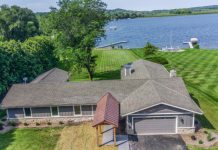
One hundred and sixty years ago, the Lord also caused his name to be recorded at the place which now is the village of Newburg, and true to his promise, his name has come and blessed many who came to hear his Word.
The village of Newburg was founded in 1847, when Barton Salisbury sent one of his workmen by the name of Watson to the place where the Village of Newburg now stands, to build a log house.
In the spring of 1848, he came to the place himself, built a dam, a sawmill, and a gristmill. These were the beginnings of Newburg. The founder was assisted by two nephews who shared their uncle’s vim and push. They built some of the first houses, among them the first hotel, the Webster House.
It was during the construction of the latter that Barton Salisbury lost his life. He was working on the roof when one of the rafters broke, and he fell down into the basement. He was mortally injured and died soon afterwards.
He intended to make Newburg the most important place in the county, but his life was cut short, and his vision never materialized.
At this same time German Lutherans began to settle in this area. The Lutheran Church in America at the time, being in its infancy, had not the men or means to serve the scattered settlers with the Word and Sacrament.
Among the preachers who came through the area were many false preachers who tried to draw them into their fold. Some people were misled. Others were aware of these preachers and could not be swayed.
Before a congregation had been founded, these early settlers, in order to not be without the Word and Sacrament entirely, called on pastors living at some distance to serve them. This was only at rare intervals.
Those Lutherans living in the Town of Farmington were served by Pastor Kluegel of Milwaukee and met at the home of Mr. Geidel, and those living in and around Newburg were served by Pastor Dietrichsen, also of
Milwaukee, and met in the schoolhouse of Newburg.
THE ORGANIZATION
PASTOR J.H. ROELL, 1859-1863
Meanwhile, Pastor J.H. Roell came from Port Richmond, New Jersey, and joined (1858) the Wisconsin Synod, which had been organized on December 8, 1849. He was first stationed at Port Washington. From there he came to West Bend. After he had organized a congregation there in 1858, he seems to have directed his attention immediately to Newburg. The following year, on April 2, 1859, the Lutherans of Newburg and vicinity met under his guidance and organized the “Deutsche Evangelische Lutherische St. Johannis-Gemeinde”
(translated: “German Evangelical Lutheran St. John’s Congregation”). The first trustees elected were: Johann Bruns (secretary), Carl Maercklein, Johann Fuchs, and Pastor Roell as president. The Articles of Incorporation are recorded in the Court House of Washington County, at West Bend, in Vol. A, Record of Religious Societies, on pages 37 and 38.
At the 1860 Synod meeting, held in Fond du Lac, May 31-June 7, St. John’s-Newburg, Muskego, St. PetrasMilwaukee, Platteville, and Ahnapee (Algoma) were accepted as members of the Wisconsin Synod. The following year Friedrich Seidemann was the first lay-delegate from St. John’s to attend a synod convention, which was held in Watertown, Wisconsin, on May 25, 1861.
No sooner had the congregation been organized when they felt the need of a place of worship. The members were not abundantly blessed with earthly goods, but God had given them a good measure of faith, which gave them courage to undertake the building of a church.
Accordingly, in 1860, the resolution was passed and a building committee of five members was elected: J. Bruns, H. Wilkens, H. Jahr, J. Bloecher, and G. Zinke.
Two lots were bought from Simon H. Van der Cook, in the Van der Cook Addition to the Village of Newburg, for $150.00. The deed contains these interesting provisions, to-wit:
“Provided always, that said lots shall be used only for purpose of erecting thereon a Church and such buildings requirable for the congregation of said society. Provided also, that said Trustees and their successors in office shall have no power of selling said Lots or part thereof, neither to lease them, nor the buildings which shall hereafter be erected thereon, without the consent of each and every one and singular member of said society, so that a veto of one member shall make such sale or lease null and void. And if said society shall be dissolved, or the members thereof withdraw as not leaving even one member, then said Lots and the buildings thereon shall belong to the German Evangelical Lutheran Synod of Wisconsin and adjoining States, and for that purpose only to be used by any other society of the same name and kind.”
At the Columbus synod meeting (June 14-18, 1862), the following report was recorded:
”Pastor Roell submitted that his Newburg congregation in connection with the building of its church had adopted a by-law and obtained legal sanction of it, to the effect that the new building would become the property
of the synod in case the congregation would disband or assume another name than Evangelical Lutheran. Such a by-law, however, was not approved by synod, it being objected that synod in no case was after the earthly goods and property of its congregations, that it must not even place itself in a bad light, as though it were seeking earthly profit and worldly power; that it rather must detest and abhor the attempt of other denominations and synods in this way to obtain the rule over congregations, and that its duty is to silence every pretext of congregations that are suspicious of synod’s obtaining their property when they become members.”
On June 20, 1862, the Wisconsin Synod executed a document relinquishing all its rights under the provisions of the deed. The following is a translation of the original document:
“The Evan.- Luth. Synod of Wisconsin and other states certify herewith that they will relinquish their rights to the church of the Ev. Luth. Congregation in Newburg, Washington Co., WI, and that the mentioned congregation is herewith entitled to change or have changed the here-mentioned modification in their bill of sale.”
Johannes Bading, President, D. Huber, Treasurer. Phil. Koehler, Secretary. Watertown, WI., 20 June 1862.
On these lots a church building measuring 32x44x20 feet was erected, the cornerstone of which was laid June 16, 1861. The speakers on this occasion were the former President of the Wisconsin Synod, Pastor Johann Muehlhaeuser and Pastor Meumann. The church was not completed until January 1, 1862. Though there was no furniture, the building was immediately used for worship. When, during the spring and summer of this year, altar, pulpit, baptismal font, and pews had been procured, the church was dedicated by Pastor Roell with the assistance of Pastors Phillip Koehler and Jacob Conrad to the service of the Triune God, August 13, 1862.
Pastor Koehler preached in the German language, while Pastor Conrad delivered an English sermon. It goes without saying that this was a day of great rejoicing for the little congregation. Their hearts’ desire, to have a place for worship, was fulfilled. Fitly could they express their joy with the words of the Psalmist:
“How amiable are thy tabernacles, O Lord of hosts! My soul longeth, yea, even fainteth, for the courts of the Lord; my heart and my flesh crieth out for the living God. Yea, the sparrow hath found a house, and the swallow a nest for herself, where she may lay her young, even thine altars, O Lord of hosts, my King and my God.” Ps. 84, 1-3 (KJV)
This building served the congregation for sixty-four years. In the record of the congregation, the cost of the church is given at approximately $2,200.00. There are four receipts in the files of the congregation, signed by T. E. Van der Cook, which read “on payment of church contract,” totaling $1,137.26. T.E. Van der Cook later built (1864) St. John’s Church in West Bend. There are also several other buildings in Newburg that could have been built by him. Mr. Van der Cook died in 1869, and he is buried in the Newburg Union cemetery.
The following year, 1863, Pastor Roell became known as one leading an immoral life. On the basis of the charges brought against him, he was deposed by this and the West Bend congregations and was also ousted from the Synod. Later Pastor E. Hoyer records that President J. Bading in 1883 received a letter from a Pastor Holke, in which Pres. Bading was advised that Pastor Roell repented on his deathbed.
Though Pastor Roell’s conduct is deeply to be deplored, yet he must be given credit for the excellent work of organization he did here.
It was through him that the Lord guided our congregation so that it became affiliated with a church body, the Wisconsin Synod, whose aim and object is to teach the Word of God in truth and purity. For this we are deeply indebted to the grace of God.










interesting to read about Newburg, back in the 1960’s my father played ball with a team from the Fillmore area, and they would play softball on Sunday afternoons, and they played on a diamond behind that church. Oh the memories when you read about these small towns.